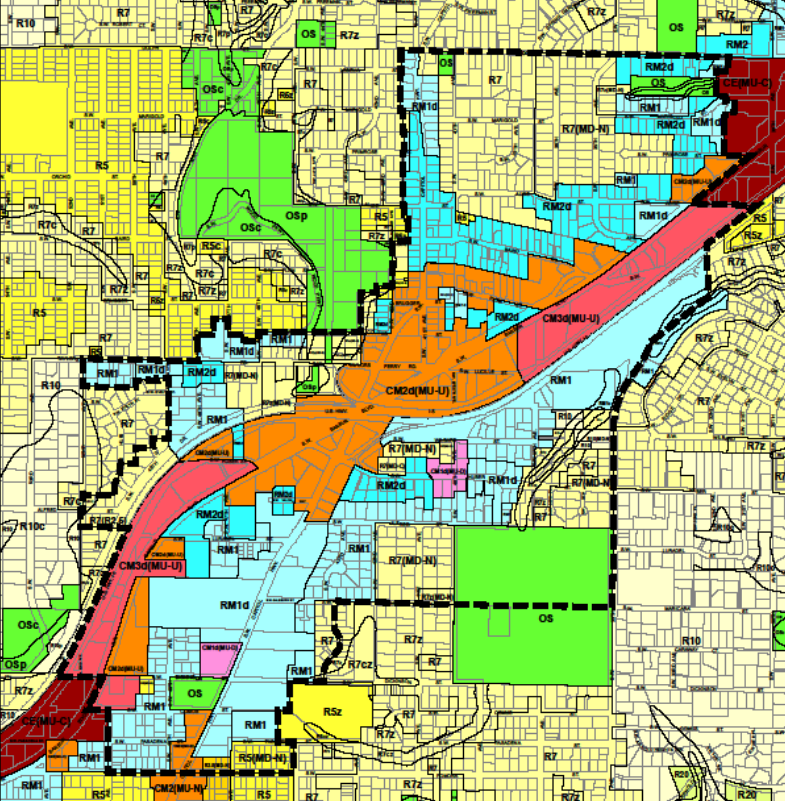
Two southwest area projects are currently taking their first steps from plan toward reality.
The Washington Square Regional Center (WSRC) is about three miles west of the West Portland Town Center (WPTC), and both are defined by the 2040 Metro regional growth plan.
So while it’s tempting to compare them — they’re near each other and rolling out at the same time — that would be unfair. In planning parlance, a “regional center” is a much more ambitious undertaking than a “town center.”
Despite that difference of scale, however, the two efforts share a similar challenge, how to transform a car-centric area into a denser, people-centered community without pricing out current residents.
It is also informative to contrast how the larger WSRC project is able to tackle transportation problems straight on, while the town center project in West Portland lacks the heft to address its major traffic circulation problems.
Tigard – Washington Square Regional Center
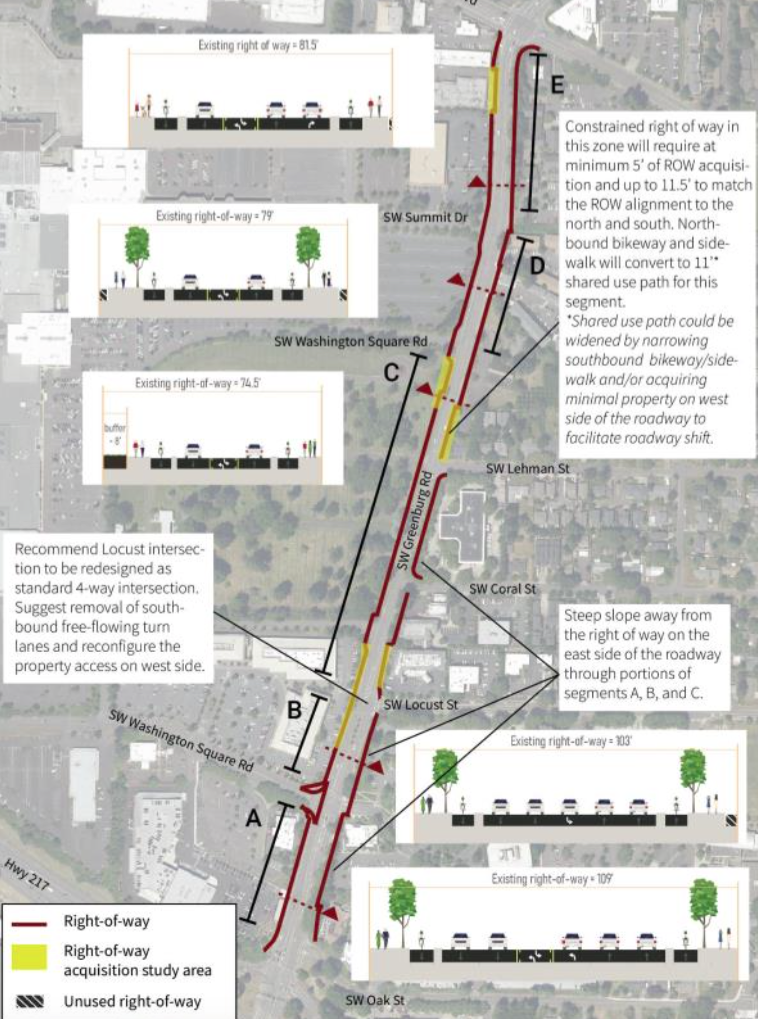
Sitting in the middle of Tigard’s regional center is the Washington Square Mall itself. The mall is owned by the real estate investment company Macerich. Macerich has ambitious plans to redevelop their holding, moving away from big box stores and toward a more urban experience.
The possibility of large private investment into the area is a nice tail-wind for the public redevelopment efforts.
Tigard has recently requested $21.5 million in Major Street Transportation Improvement Project (MSTIP) funds from Washington County to transform the arterial on the mall’s eastern border into a “complete street.” MSTIP is funded by a county-wide property tax unique among the Metro counties, and has delivered $900 million toward 150 projects over the past three and a half decades.
I recently met with David Roth, a Senior Transportation Planner with the City of Tigard, to talk about the Greenburg Road project, and the regional center in general.
Roth pointed out that Greenburg Road divides the mall from the Metzger neighborhood, home to many residents who face a high risk of displacement as the area redevelops. The project would provide safe crossings from Metzger to the retail center, as well as remedy the corridor’s many active transportation deficiencies.
He explained that the team had prioritized five transportation projects, with Greenburg having the highest priority. “Greenburg is a good project to start with. It will be a demonstration project that makes future projects easier to pursue.”
Other high-priority transportation projects included bicycle and pedestrian improvements at the Hwy 217 interchange, and a possible over-crossing at 95th Ave to allow safe bicycle and pedestrian connections to the Fanno Creek trail to the west.
“We are trying to establish a precedent for good planning and best practice for design to show what can be done,” remarked Roth. The Washington County Board of Commissioners will decide on project funding in the winter of 2023.
West Portland Town Center
Last week in Portland, the Bureau of Planning and Sustainability (BPS) presented its draft West Portland Town Center plan to City Council, with a vote to adopt coming up on October 27th.
About six minutes into the BPS staff presentation, Commissioner Jo Ann Hardesty asked the first of what ended up being a series of questions about land speculation and anti-displacement strategies. For several minutes the hearing became a conversational back-and-forth about zoning, densification strategies and infrastructure needs.
The exchange brought into relief the challenges of trying to increase density in an area with inadequate infrastructure—and without a commitment from the city to provide the needed capital to remedy the situation. (In Southwest Portland “inadequate infrastructure” usually means lack of stormwater facilities.)
Absent a way to fund stormwater infrastructure, the plan follows a two-phased zoning change strategy based on infrastructure readiness. The first phase immediately upzones areas ready to support densification. Identified as second phase is land which BPS would like to upzone, but cannot because of stormwater treatment deficiencies. Hardesty’s concern, and the Mayor joined her with questions, was that the interval between phases allowed for land speculation.
With the focus on zoning and speculation, the future town center’s transportation problems were not discussed.
Wrap up
The West Portland Town Center sits on a traffic quagmire formed by the crossing of SW Barbur Blvd and I-5, both under ODOT jurisdictional control. Many people have remarked that decommissioning ramps to and from I-5 would be a key step toward improving area safety and circulation.
But a town center plan doesn’t have the heft to activate traffic change of that magnitude. Zoning changes and Comprehensive Plan updates don’t cost much, so the focus becomes modelling a “new approach to equitable growth.” That, and phased plans to be activated if funds become available in the future.
The SW Corridor light rail project, had it passed, would have helped with some of the area’s stormwater problems. Without it, the WPTC no longer benefits from the synergy a better-funded and bigger project could provide to it.



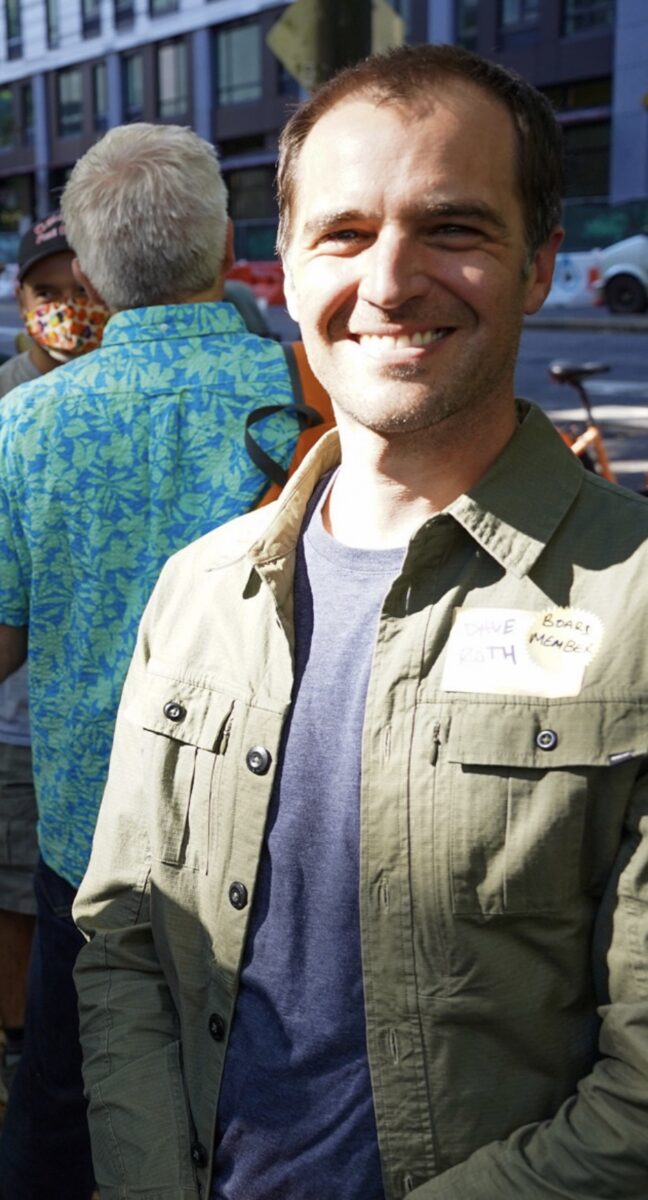
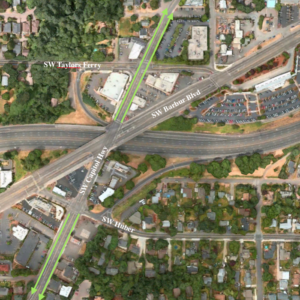
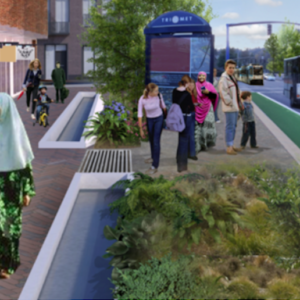
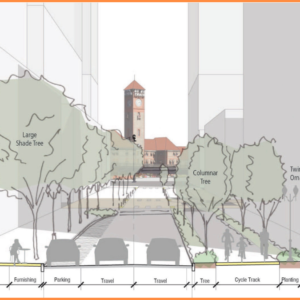
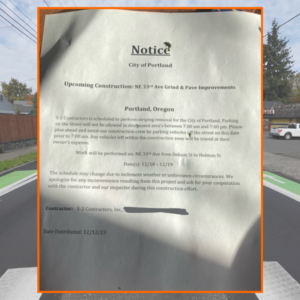
Thanks for reading.
BikePortland has served this community with independent community journalism since 2005. We rely on subscriptions from readers like you to survive. Your financial support is vital in keeping this valuable resource alive and well.
Please subscribe today to strengthen and expand our work.
This is just more of the status quo on Greensburg road. 11ft lanes on a road with a posted speed limit of 30mph is absolutely clueless in 2022. One of the sections is still going to be 6 total car lanes wide. Calling this a “complete street” is joke when almost 2/3 of the street is dedicated towards car dedicated infrastructure. All this project will show that slapping a bike lane to an arterial is not going to invite more bicycle usage.
More information on Greensburg Rd is here https://www.tigard-or.gov/home/showpublisheddocument/2267/637831325012400000
I always thought the West Portland Town Center was sort of strangely placed. There really isn’t much to write home about, and it seems to me that the amount of work required to build safe infrastructure there is really daunting. Downtown Multnomah Village always seemed to be a more natural place for a “town center” – seeing as it really already is one. Upzoning Multnomah Village would presumably be more politically contentious though – not really familiar with the area outside a few visits here and there.
I think a lot of the Metro 2040 plan is good, but man I do not understand the choice of Washington Square as a regional center. Combining the lowest ridership station on a barely used commuter rail service, a suburban shopping center, and a golf course bisected by a freeway does not induce a lot of excitement in me. I guess I could say the same thing about Clackamas and Gateway though. Apparently Metro is working on both an update for 2045 and 2070, will be interested to see what they change.
Agreed! The intersection of Barbur, Capital Hwy, and Taylors Ferry is home to two freeway on ramps (I-5), not to mention that Barbur itself is a State Highway that regularly sees auto speeds over 50mph. While I’m in favor of whatever safety measures and density planning they can implement along here (the Capital Hwy improvements are already pretty great), this Town Center branding is baffling to me without DRASTIC changes to Barbur all that way from the city line to downtown. (eg single auto lane in each direction with BRT or light rail/bike lines assuming the rest of the ROW). I’m afraid we’re just going to see a lot of half-measures like we’ve seen on other orphan highways around town.
I live nearby and agree 100%. The main strip in Multnomah Village is a really great start that would make a ton of sense to improve upon. But as you hint at, this is the neighborhood of Amanda Fritz and her friends who love their “oasis of 10,000 sq. ft. lots in the city.” I quit Nextdoor around the time the neighborhood was in an uproar about a relatively small apartment building that was built a few years ago. I can’t imagine the backlash around more significant changes.
Amanda Fritz testified at the WPTC hearing. I got the impression that she lived in West Portland Park. I will have to relisten, but I seem to remember her saying that WPTC was the only TC that was initiated locally, by the neighborhood, and that she was, as a neighborhood advocate, involved w making that happen.
Regarding MV as a town center, Hillsdale is just a half mile to the east, it’s got a TC designation.
Given the impact of covid and so many more professionals working from home, as well as big box retail being eaten up by online sales, do we even need regional and town centers any more? Wouldn’t neighborhood nodes make more sense, complete with a few eateries, a boutique or three, a bike repair work station, a few connecting buses, and a park or community center?
If you don’t build the density that comes along with a town center, you just end up with one more car centric neighborhood.
Hopefully an improved version of the Southwest Corridor project gets referred to voters for round two in 2024.
Yes please. Get rid of the hidden highway projects and find a funding source that won’t hamstring Trimet. Maybe some IIJA money can be used to build the SW MAX line?
If they are going to use Barbur, they should just make it another FX line. Don’t spend the money on rail unless you are going to do it right (tunnel that hits OHSU directly, Hillsdale, and Multnomah before emerging at Capitol/Barbur).
Specifically we voted on the T2020 measure to fund a collection of transportation projects, including the southwest corridor MAX. The southwest corridor MAX project itself was not put to a vote.
Exactly. I would vote yes on just the MAX project. It was all the hidden attached highway projects that I couldn’t stomach.
Interestingly, Trimet’s “Forward Together” service concept plan decreases transit service to both centers. Comments are due Oct. 31 if you haven’t taken the survey yet (TriMet.org/forward). Post-COVID commuters tend to be employees in retail, medical/healthcare and manufacturing jobs, as well as students seeking educational opportunities. TriMet’s proposed service cuts on the west side, coupled with poor infrastructure, contribute to over-reliance on automobiles, which is what we don’t want. Cleaner cars (per Portland’s Climate Action plan) and clean congestion make conditions unsafe for anyone walking and biking. The best Town Center plans aren’t going to change that scenario, or make affordable housing affordable, without better and safer alternative modes. Thanks for another good article, Lisa.
I do agree with your sentiment, but neither Washington Square nor the West Portland Town Center is loosing any meaningful bus service. Only line 64 is going away, which is a commuter line without weekend service but line 43 will be getting regular 30 minute bus service. Sure, with the rerouting of 43 means it will require a transfer to go from WPTC to Washington Square, but those routes (12 & 76) are both frequent service with weekend service routes compared to the existing commuter service hours 43 provides.
All the service cuts in SW are commuter service to wealthy, low density, low ridership suburbia. Trimet is still providing bus service to where there is currently (and planned) lower income housing, important service jobs, and to PCC.
I haven’t said much about the planned Trimet changes because I think, in light of the budget issues they’re facing, the choices they’ve proposed are the best of a lot of not-great options. But, this comment feels like a dismissive over-generalization.
There are certainly a lot of wealthy homes in the area facing service cuts. But there are also still a bunch of smaller, middle class homes sprinkled here, some owner-occupied, some rentals. There’s also missing middle housing that is invisible to many (though I certainly wish there was more). The area you’re dismissing is losing 3 bus lines (65, 39, 38) and most of a 4th (43). The loss of transit along Terwilliger in particular is going to be a blow to a bunch of people who aren’t wealthy suburbanites.
This isn’t even to mention that there’s a college, law school, and grad school in this area that will all be losing transit service.
I’m not saying these cuts are good by any means or that there doesn’t exist lower income people in the area but the data disagrees with you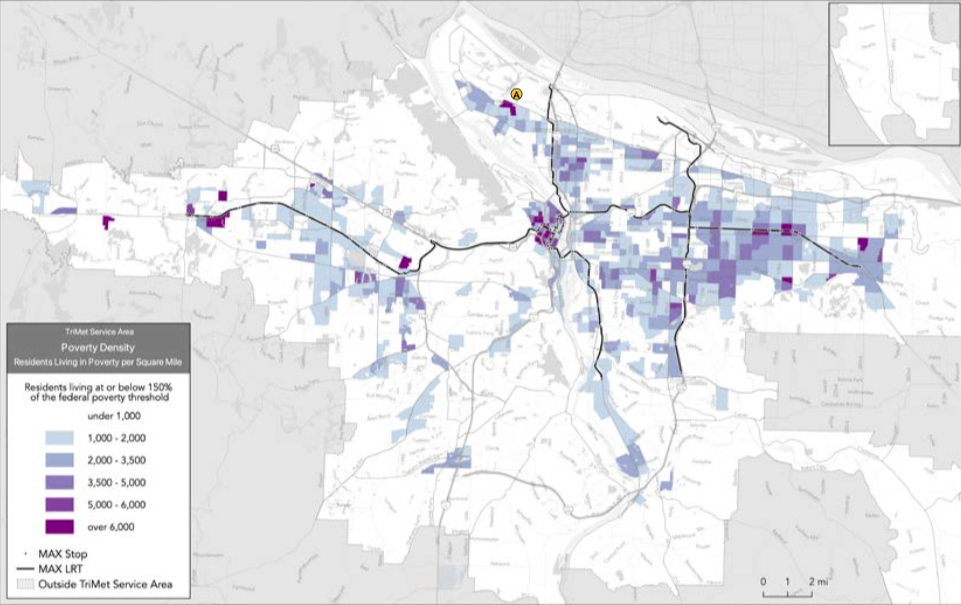
All of the “missing middle”, smaller appartment housing and condos that I have seen is off of Barbur and BH Hwy. I haven’t ever seen any of that off Terwilliger. It is all SFH and in 2022, owning a house in this area puts you very very far ahead in life than not.
I am surprised that Lewis and Clark is loosing bus service and hopefully they can figure out how to keep serving it.
Like I said, it makes sense if you’re going to make cuts with an equitable lens the cuts they’ve proposed make sense. If someone has to choose between cutting service in just about any other neighborhood in N, NE, or SE, and this ~2 square miles in SW, then it’s far more equitable to cut it in my neck o’ the woods. But that map only tells part of the story. 150% of the federal poverty threshold is $19,320 for an individual. There’s a big gap between $20k/year and being wealthy.
There are definitely folks who aren’t wealthy or even near the Portland median income in this neighborhood. The missing middle housing is there as well (though I think most of us in this comment section could agree that there should be more). I walk by it all the time and have friends who rent in the neighborhood. And as I’m typing this I realize I forgot to even mention the service workers at the L&C campuses and businesses on Terwilliger in my last comment.
These cuts are gonna suck for a bunch of folks who aren’t rich and it’s a bummer to see the cuts being dismissed like these people don’t exist.
but those people are on the westside are so “wealthy.” The bus cuts on the westside will hurt many people and businesses. Plus, bus 45 needs to be rerouted to go from downtown Beaverton to Garden Home and over the Sellwood Bridge to the Clackamas town center as TriMet proposed in early 2020. Then, TriMet can have buses 1 and 37 take over the lost service for the 45.
I think there is some fundamental issue with the way that all of this is framed. While equity is a good thing to “shoot for”, I find there is usually some underlying tone of “rich people don’t need transit service” that I think is self-defeating in the long run for TriMet and the area. Lower-income people certainly might need transit more but cutting service to all the high-income parts of the region just further cements the idea that transit is worse than private automobiles.
And while, sure, that’s the prevailing attitude in the entire country and maybe it’s a bit unreasonable for one local transit agency to upend a century plus of car culture I don’t think full capitulation to it makes much sense either. Especially in a longer term strategic way
Not to mention, I find the granularity of “service areas” to be a bit too nebulous and large. If a service area has 10,000 people, and 500 of them (5%) are transit dependent based on income – cutting service to them is devastating. All of this really further cements a “poor part of town” and “rich part of town” class divide that just bugs me a bit.
Just a thought though, I do think there is a need to provide better bus service in east Portland especially – but I am firmly against some of the stated reasons for cuts (as well as cuts on the principle – everyone deserves transit means everyone)
Thank you for writing that, Andrew.
Yeah, I’ve had similar thoughts as well. It’s a complicated issue but overall I think service cuts aren’t the solution that’s needed here.